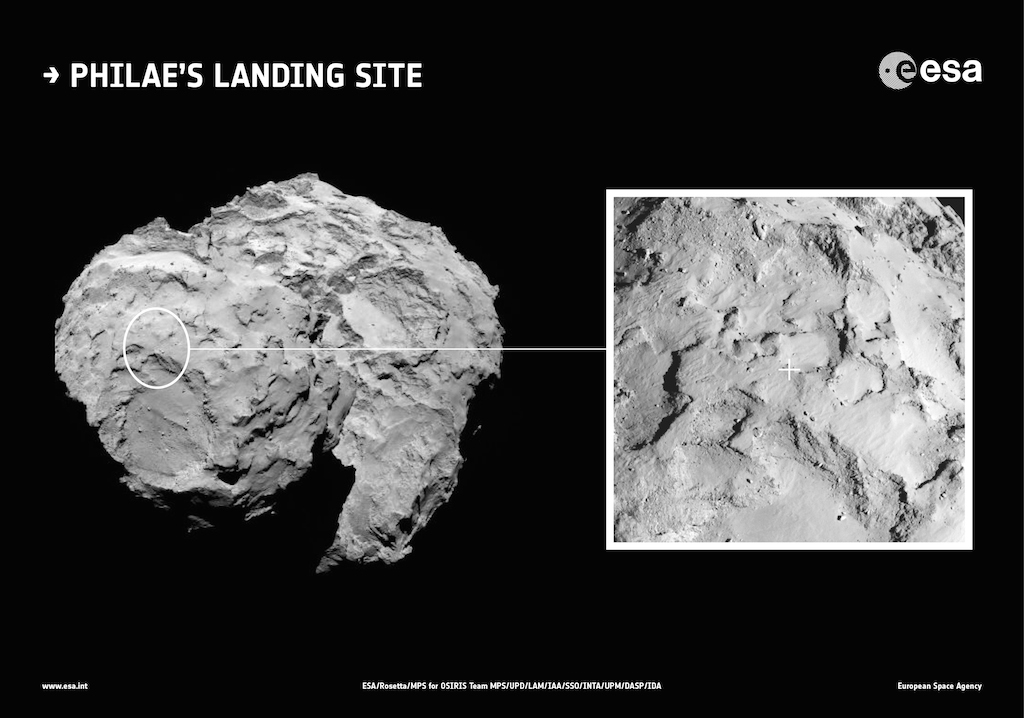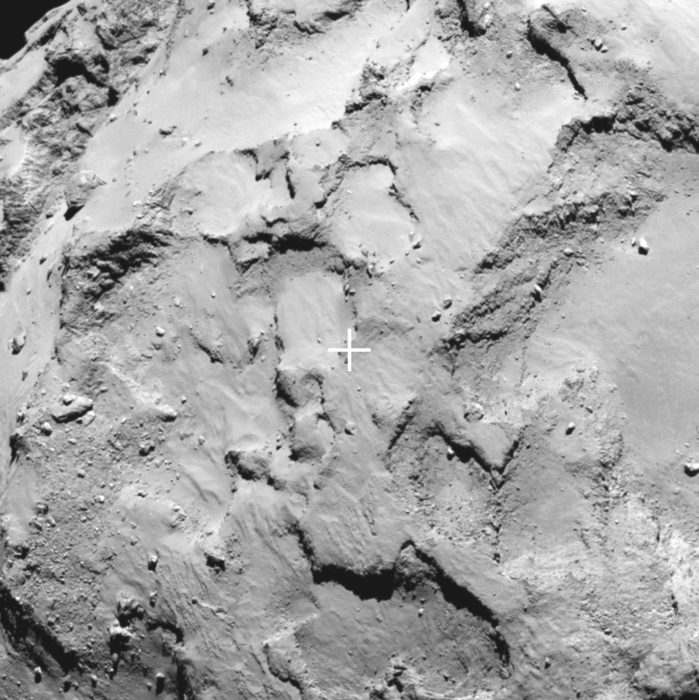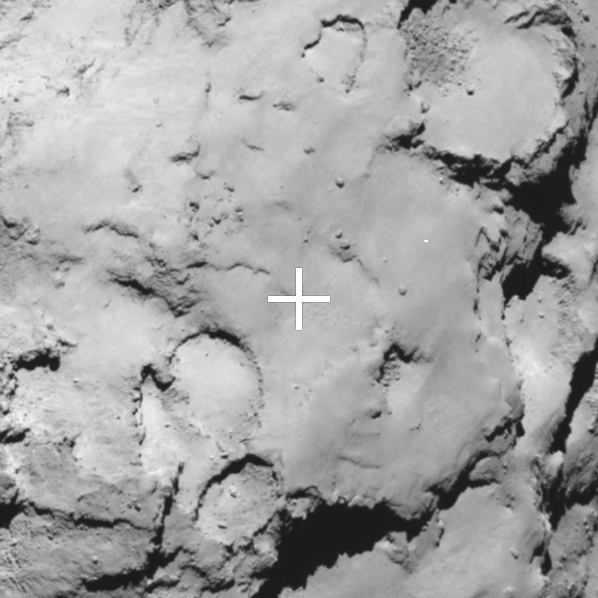The die is cast: Rosetta’s lander Philae will target Site J, an intriguing region on the ‘head’ of Comet 67P/Churyumov–Gerasimenko.

The location of the primary landing site for Rosetta’s lander Philae shown in context of comet 67P/C-G.
Credit: ESA/Rosetta/MPS for OSIRIS Team MPS/UPD/LAM/IAA/SSO/INTA/UPM/DASP/IDA
The chosen site offers unique scientific potential, with hints of activity nearby, and minimum risk to the lander compared to the other candidate sites. The decision to select Site J as the primary site was unanimous. The backup, Site C, is located on the ‘body’ of the comet.
Philae is planned to reach the surface on 11 November. The landing date should be confirmed on 26 September after further trajectory analysis and the final Go/No Go for a landing at the primary site will follow a comprehensive readiness review on 14 October.
Read the full story on how the landing site was chosen: ‘J’ marks the spot for Rosetta’s lander.

Close-up on Philae’s primary landing site (Site J).
Credit: ESA/Rosetta/MPS for OSIRIS Team MPS/UPD/LAM/IAA/SSO/INTA/UPM/DASP/IDA

Close-up on Philae’s backup landing site (Site C).
Credit: ESA/Rosetta/MPS for OSIRIS Team MPS/UPD/LAM/IAA/SSO/INTA/UPM/DASP/IDA
The landing site was announced this morning at ESA Headquarters.
Watch a full replay of the Rosetta landing site announcement here.









Discussion: 41 comments
But in what time and in which day?
Good point, Luigi. The lander is planned to reach the surface on 11 November, but the landing date will be confirmed in the coming weeks. The relevant information is now added to this blog post, and you can find more details in the full story: https://www.esa.int/Our_Activities/Space_Science/Rosetta/J_marks_the_spot_for_Rosetta_s_lander
What will be the difference in horizontal speed once Philae reaches the comet? Will the trajectory somehow sync with the rotation of the comet in order to avoid that the landing elipse becomes to large or that a big difference in speed may harm the lander and land it “straight down” as it is shown in the animations. Or even worse that it will be hit by some protruding rocks.
I am so eager to see the separation pictures.
Will the NAVCOM be able to take pictures of the descent?
It is hard to describe the feeling I get knowing that I was able to “participate” in the selection of a landing site for Philae. Of course I wasn’t TRULY involved, but, along with those of us amateur scientists, we get an immense reward knowing we were allowed to tag along.and learn along the way.
I had picked Site A, and, oddly enough, I couldn’t be happier at being wrong! I wasn’t just wrong, I was educated in learning WHY I was wrong..
The next two months are going to be exciting.
Go Rosetta! Go Philae!
Nice, that does look like an interesting region. I was expecting site B because it looks a lot flatter!
I think the problem with site B, as per the VITRIS measurements is that may be too cold as it is near the coldest part of the head, which would result in more activity which could in the end cause peril to the craft itself. Site J is more on the edge of the warm zone before it meets the cold. I think when they showed the VIRTIS data and where most of the activity was, top of head and body, and neck, that at least site A was ruled out.
I think the dunes are thin dust layers draping underneath harder structures and if so the risk of sinking too deep is reduced, good choise. Glad i can see no vent cavities. The estimated accuray of the landing on this spot would be nice to know.
Crikey! There are so many cliff edges in that area. Ok if the lander slips over a cliff the rate of fall will be low, but what happens in it lads on its back?
Very brave.
Site J is probably the best choice of landing sites in terms of topography, local slopes. relative velocity vectors and “pristine” versus “active”.
And, of course, one big deciding factor is the useability of the site for the CONSERT experiment.
–Bill
Best luck, but this region seems to be quite full of cliffs and a lot of boulders, the area immediately below “J” on the big picture looks much better and saver to me!
Feels like Atacama!
I would like to know what will the obital period for Rosetta be when Philae is released ?
Absolutley stunning project, Scientists and Engineers, I am truly proud to be European (even if I am British….)
Looks like it is the best site for CONSERT radio experiment.
I was hypo that that top o head crater actually compressed the core neck material, and “spalled” out the chunks to make the rest of the neck.
Now we can test that hypo, and see if we density info to match !
The lander team was expecting a hard surface too.
https://www.dlr.de/dlr/en/desktopdefault.aspx/tabid-10394/663_read-11557/
After a great day, the site has been chosen,lots of excellent PR, the project already a massive achievement, a landing spot picked that looks more complicated than any we have seen including the first moon landing. So hugely ambitious.
So how did you mange to finish the the otherwise excellent explanation of why the site was chosen with yet another version of;
something like the comet comes from an epoch at the forming of the solar system so will contain material from before the earth or something like it.
Surely by now, with all the information of new solar systems we have seen since Rosetta took off, Virtually every one is now sure that the story of the formation of our solar system is incorrect. So how can we possibly hold on to the idea that the comet was formed from the process of the solar system birth, when its hard to make this fairy tale fit any of the new systems let alone our own..
Surely its getting to the stage where repeating this over and over again is just too unimaginative and unambitious.
After the fantastic work you have already done and the ground breaking science to come, it just puts a downer on things, almost a straight jacket.
BUT continue to have the great luck you have worked so hard for.
Great mission, looking forward to results what ever they bring.
Hi Dave, I am not sure what you mean. In what other way do you think comets have formed, if not as some kind of remnants of the development of our solar System? surely there are many questions and uncertainties remaining, but what radical alternative Theorie do you propose?
Oh, pleasent cold nights and sunny days for the Akkus, what a paradise for philae !
Go, Rosetta !
No fear sparking.
😉
It is clear that the enlargement just above of site J is rotated 90 degrees with respect to the smaller enlargement paired with the image of the whole body. Is the latter also rotated with respect to the whole body? I can’t make them match up. Perhaps they were made under differing illumination?
The big enlargement of site J just above is clearly rotated 90 degrees with respect to the smaller enlargement paired with the whole body image on top. Is the smaller enlargement also rotated with respect to the image of the whole body? Can you bring the images into harmony??
I couldnt get past the first line of this. The idiom the author was looking for is “The die is cast”. Truly poor editing
Claudia – “The dice is cast:…” Surely you mean “The DIE is cast.”? Dice is the plural of die.
Anyway, great news on the landing site. Go Rosetta, Go Philae!
Thanks for spotting! That was a spur-of-the-moment translation of “alea iacta est” in the excitement of the landing site announcement, it’s been corrected now.
According to Oxford Dictionaries:
“Historically, dice is the plural of die, but in modern standard English dice is both the singular and the plural”
Yikes, this event appears to have overloaded your website’s video server. Tried to download the landing site announcement video from https://wpc.50e6.edgecastcdn.net/8050E6/mmedia-http/download/public/videos/2014/09/041/1409_041_AR_EN.mp4 at 11am, 12 noon, 12:30 pm and 2 pm (AEST), Downloads first few kilobytes, then reports it will take up to two days to download. Tried again just now (6:50 pm), and download would take 171 hours at 1.35 KB/s for the 602 MB.
Normal download rate from ESA is between 150 and 800 KB/s on broadband.
Oh, well, I shall just have to try again tomorrow, by which time the demand on your server may have abated. Meanwhile, I shall re-read this excellent blog and the accompanying ESA releases.
Cheers,
Andrew Rennie
It would be of immense help in visualizing the size and scale of the comet, and especially the close-ups such as the landing sites, if a bar scale was routinely added to the photos; or at the very least, the pixel resolution (metres/pixel) so that we can add our own scales to the images. This would be especially useful for amateur astronomers and the general public who are looking at these images.
Looking at the choosen landing site J , I see hills , ridges , boulders and other irregular features , all not very promising for a successful landing . Is the choise definitif ? Good Luck !!
The choice was “anonymous” and clearly preferable to the other four sites. One is left to assume that there are other, more compelling reasons for the choice which have not yet been disclosed. My bet is that the top-priority concern was to choose a site as far away as possible, and providing relative shelter, from those deadly-looking jets shooting out of the neck region, the nature of which has, strangely, not yet been disclosed either. Sorry to sound rather gloomy, but it doesn’t bode well for the outcome of the Philae part of the mission…
Sorry, that should of course have been “The choice was “unanimous” …
Don’t worry, it won’t be damaged by those super strong electrical phenomena’s you are trying to promote as mainstream science.
Sadly, there is quite a high chance of failure and it would be because it lands on a big rock or simply upside down…
If Philae’s circuits short out during the descent, as I fear, I guess that will be proof of the electric nature of those “jets”.
I assume you’re being ironic when you suggest I’m promoting mainstream science. The confirmation of the electric discharge phenomena which we can see issuing from those hot-spots on the neck will, on the contrary, be the last nail in the coffin of the mainstream “dirty snowball” model.
This looks like a dusty place where a part of the «ejected cometary dust» fell back on the surface whether by gravity or static electricity (seen on the Moon).
Because of the weak gravity, I expect it to be fluffy. That’s perfect for a soft landing, but the dust might rise, linger around, stick and cover up some crucial pieces of equipment. You really don’t want that to happen.
Also, if that place is cover up with loose dust, the ice screws won’t be able to reach the harder icy material.
That’s also something you might not want.
Hi Jim. Thermal inertia should give a good idea of how old dust deposits are. Even on micro-gravity time tells it all. Another instruments of help, too.
Don’t expect ice up there.
🙂
On the next mission to c-g (!) I suggest using something like the Dropship (with thrusters) or some other system to make a controlled landing insted of a drop. It seem odd that Rosetta can approach her target at astronomical distance and then Philae beeing dropped off like a world war 1 parachutist. Oh! I am just so worried. Will You Esa people please make a cross your fingers happening? I mean it worked with the wake up Rosetta, did it not?
You have to remember, Rosetta was sent back when the tech was parachutes. It went just after the MER rovers which used the Chut+Ball landing. The newest way to land was the sky crane for Curiosity which didn’t occur til 2012. A ball landing would be too drastic due to the cliffs, so the parachutes were the best approach at the time.
Given the size/mass/complexity/power of Philae, I don’t think a controlled landing was an option. It’s a lot more complex you see, you need a complete propulsion&AOCS system (more mass => less instruments), you need a lot more computation power (assuming visual navigation) => more powerful and power hungry computer…
It was just not an option!
Whatever is cast , die or dice , let’s speak with Caesar : Alea iacta est”….
And , at 2nd thought , site J is rhe river Rubicon ….
Can we get a full pixel rez image of site J and C close ups? I’d like to check out feature distances.
From the “Where is Rosetta” map, it seems that in mid-November Mars is very nearly on a straight line from Earth to 67P/CG. When seen in three dimensions this is unlikely to be true because of the inclination of the comet’s orbit. But from the point of view of people trying to watch the comet (estimated at magnitude 19) at that time with suitable telescopes, Mars might act as a nice finder in the sky.